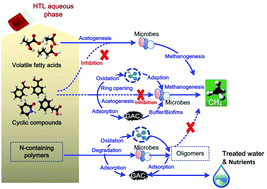Anaerobic conversion of the hydrothermal liquefaction aqueous phase: fate of organics and intensification with granule activated carbon/ozone pretreatment†
Abstract
Hydrothermal liquefaction (HTL) is considered to be a promising route for biofuel production from wet biomass. Transportation fuels and chemicals can be accessed through this process. However, a high strength aqueous phase is also produced during HTL. The conversion of the aqueous phase could significantly contribute to energy and nutrient recovery. Anaerobic fermentation has recently been proposed to biologically convert the HTL aqueous phase into biomethane. However, only a limited amount of information about the fate of the HTL aqueous phase and its conversion during anaerobic conversion is available, and it suffers from a few setbacks, including a low degradation efficiency of organics (33–64% COD) and high dilution rates (5–1000). Herein, the fates and conversion of organics in the HTL aqueous phase during anaerobic conversion were investigated by matrix-assisted laser desorption/ionization time of flight mass spectrometry (MALDI-TOF-MS), gas chromatography-mass spectrometry (GC-MS) and high performance liquid chromatography (HPLC). MALDI-TOF-MS analysis combined with organics/nitrogen balance indicated that the remaining organics (over 30%) after anaerobic conversion might come from nitrogen-containing polymers (over 1000 Da). These nitrogen-containing polymers tended to be converted into oligomers and led to a decrease in the molecular weight (100–300 Da) by anaerobic microbes but could not be further converted into methane. Organic acids and potential inhibitors (N-heterocycles and aromatic compounds) could be completely converted into methane, but the acetogenesis of anaerobic fermentation was inhibited with an increased fermentation concentration. Ozone pretreatment and granule activated carbon (GAC) addition were integrated to improve the anaerobic conversion efficiency of the HTL aqueous phase. Ozone pretreatment significantly improved the conversion of organics and methane production by 109% through converting the inhibitors. At the same time, ozone pretreatment could convert nitrogen-containing polymers into low molecular weight organics, but organics with a molecular weight ranging from 500 to 1000 Da were produced and could not be converted by microbes or adsorbed by GAC. In comparison, GAC addition increased the methane yield more remarkably by 298% at a 2× dilution rate of the HTL aqueous phase through adsorbing inhibitors and enriching robust microbes, such as detoxification bacteria and syntrophic acetogens. Moreover, GAC adsorbed the recalcitrant organics and resulted in a removal of organics of 93.3–96.8%. Therefore, clean water with polished nutrients could be achieved through intensified anaerobic conversion, which could enhance the following biomass production and nutrient recovery through algae cultivation.

- This article is part of the themed collections: Celebrating Latin American Talent in Chemistry and Green Biorefinery Technologies based on Waste Biomass


 Please wait while we load your content...
Please wait while we load your content...